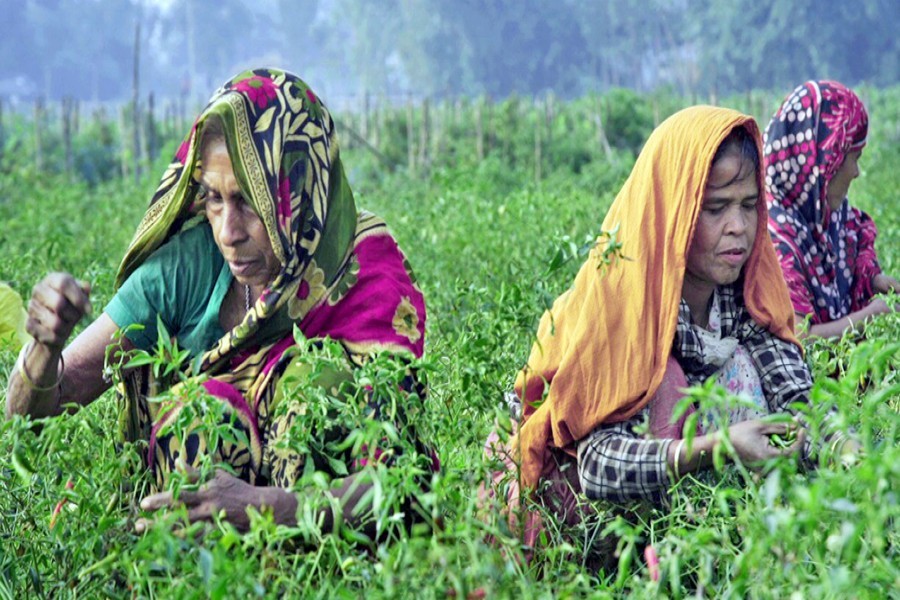Establishment of an effective value chain contributes to the rise in income and nutrition intake alongside creating gender-sensitivity among farm communities in many parts of Jamalpur district.
The selection of suitable crops, quality seeds, practice of good agriculture and access to modern farm machinery at subsidised rates also contributed to their success a lot in three upazilas of the district, as the income of many farm households, who have access to direct market channels, has increased by 74 per cent, observed during a recent visit.
A total of nine new collection points have been established and a 108 community sales agents have been made with the help of the World Vision Bangladesh (WVB)'s Nutrition-Sensitive Value Chains for Smallholder Farmers (NSVC) Project, which is jointly being implemented with WVB's local partner Unnayan Shangha.
The Australian government is funding the six-year-long project worth US$ 5.77 million through the Australian NGO Cooperation Program (ANCP) in 21 unions under Jamalpur Sadar, Dewanganj and Islampur upazilas - the project is expected to be completed by June 2023.
A total 20,000 families have been involved in the income-generating activities through this project which helped form 800 producer groups.
However, the farming and marketing methods have been able to generate profits and above 65 per cent of the beneficiaries of the project are women farmer-cum-entrepreneurs.
Lima Akter, a farmer at Bhaduria in Mesta union of Jamalpur Sadar, said she had been cultivating chilli on her 70 decimals of land.
Using hybrid chilli varieties, she could produce 75-78 maunds of chilli from which she could make a profit of Tk 0.11 million until February 15 (Mid-Falgun).
After the final collection of chilli, she will cultivate hybrid rice varieties on 50 decimals which also could help get at least 38 maunds of paddy worth Tk 37,000. The hay could be sold at Tk 7,000-8,000, she said.
Ms Lima said her earnings per month had increased to Tk 18,000 from Tk 10,500 earlier.
She said sales centres within the union, set up by WVB, was the key factor for their recent success.
Community sales agents (CSAs) collect crops of all farmers of the villages and exhibit those at a common market place at a time, thus increasing bargain power, she said.
Md Farid Uddin, a CSA at Bot Tola under Bashchara Union in Jamalpur, said, "I get Tk 500-800 by selling 4.0 tonnes of paddy (100 maunds). I also have a sub-dealership of agricultural inputs through which farmers could get access to modern seeds, fertiliser and crop protection products."
Like Ms Lima, income of Mrs Kamrunnahar and her husband Md Delowar Hossain have also increased notably as they cultivate three crops - Boro, Aman and Mustard - in around 70 decimals of land owned by them.
Kamrunnahar has also become an entrepreneur by buying a power tiller at a subsidised rate, helping the couple make an additional Tk 43,000-45,000 in two rice growing seasons as well as reducing production costs of their own crop fields. Kamrunnahar bought the power tiller at Tk 0.137 million, of which 25 per cent was subsidised by the WVB's NSVC project.
Kamrunnahar said the most positive thing of the change was that respect for women among men in the villages had increased and women were equally contributing to the decision making.
She said males and females were getting regular training from the Unnayan Shangha workers on women education, social-religious behaviour towards family members, healthy food and nutrition intakes, women and child health, good agriculture practice and so on.
Shanti Begum at Jamira village in Bashchara union of Jamalpur Sadar also bought a subsidised power tiller with help of the project.
She runs the machine when her husband Nazrul is busy with other tasks.
Nazrul said the family could afford food four times now and their two sons could have intakes of balanced foods. Their sons are now studying at a nearby madrasa school.
Asked, Asim R Chatterjee, project manager of NSVC, said the project had brought 20,000 families under its umbrella so far, aiming to boost crop production and establish an effective value chain which ultimately could help raise income, nutrition intake and gender awareness among the communities.
He said 122 women had also become successful entrepreneurs under the project and they had been able to increase their income notably.
A total of 108 CSAs are working under the project among 800 producer groups, he said.
And from the cultivation to marketing, he said they had tried to build an effective value chain.
He said chilli, rice, maize, eggplant and leafy vegetables were the key five crops that farmers were encouraged to grow.
However, a mid-phase evaluation report of the project showed that income of the families under the project had increased by above 74 per cent in the last five years.
The 65.8 per cent of the producer groups' families can now spend on their children's health when they become sick - the percentage was 45.1 per cent earlier.
The rate of nutritious food consumption for child wellbeing has increased to 93.3 per cent which was earlier 23.3 per cent, said the mid-phase report.
Production of different kinds of crops has also increased notably - Boro by 24 per cent, chilli 197 per cent and maize 50 per cent, said the report.


